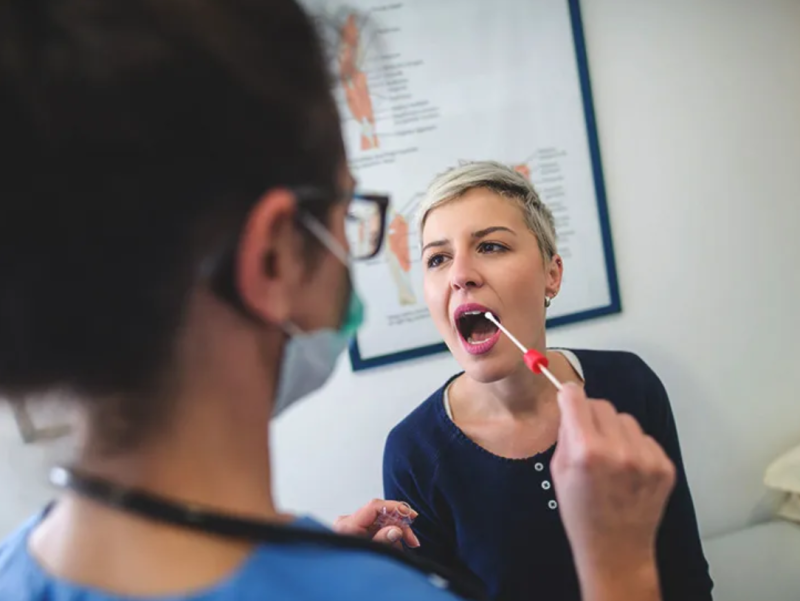 Plaques in the throat are white spots in various areas of the oral tract. In general, they result from the action of bacteria at the level of the tonsils and adjacent areas, which is why they usually require medical attention.
The mucosal environment facilitates its dissemination. Sometimes, the microorganisms causing the condition spread to the tonsils, larynx, pharynx, palate, or tongue. They usually generate various discomforts, such as pain and fever.
According to some studies, this problem is common, especially among school-age children. This is because little ones frequently put toys or other unclean objects in their mouths. Below, you will find general information about plaques in the throat so that you know how to deal with them.
Plaques in the throat are white spots in various areas of the oral tract. In general, they result from the action of bacteria at the level of the tonsils and adjacent areas, which is why they usually require medical attention.
The mucosal environment facilitates its dissemination. Sometimes, the microorganisms causing the condition spread to the tonsils, larynx, pharynx, palate, or tongue. They usually generate various discomforts, such as pain and fever.
According to some studies, this problem is common, especially among school-age children. This is because little ones frequently put toys or other unclean objects in their mouths. Below, you will find general information about plaques in the throat so that you know how to deal with them.
Contents
What are plaques in the throat?
 The plaques in the throat are secretions of a substance called “pus,” which has a thick and viscous appearance. They are usually whitish, yellowish, or greenish. They have the shape of a grain of rice or grains about to ooze, like a pimple.
This alteration’s presence will indicate a bacterial infection in most cases. Viral infections, despite being more common, do not usually cause the appearance of whitish plaques but rather are characterized by redness and inflammation in the area.
The plaques in the throat are secretions of a substance called “pus,” which has a thick and viscous appearance. They are usually whitish, yellowish, or greenish. They have the shape of a grain of rice or grains about to ooze, like a pimple.
This alteration’s presence will indicate a bacterial infection in most cases. Viral infections, despite being more common, do not usually cause the appearance of whitish plaques but rather are characterized by redness and inflammation in the area.
Causes of plaques in the throat
Plaques in the throat should not be confused with tonsilloliths, white dots that sometimes appear in the oral cavity and are due to the biofilm formed by bacteria. The plaques are caused by a bacterial or viral infectious process in very few cases, as indicated. The tonsils are the first line of defense against microorganisms that enter the body through the mouth. Therefore, it is not uncommon for infections to incubate in that area. Sometimes plaques in the throat appear due to the direct action of microorganisms. Other times they are a manifestation of associated diseases. The diseases that most frequently give rise to plaques in the throat are streptococcal tonsillitis, diphtheria, mononucleosis, oral candidiasis, or leukoplakia.Symptoms of plaques in the throat
 First, it is important to emphasize that the plaques in the throat are not a pathology per se. They are a clinical manifestation of an infectious process in the tonsils or some other nearby anatomical structure.
The main symptom that people present is inflammation of the tonsils. This area tends to increase in size and turn red. It also highlights the appearance of the typical white spots on the throat, this being the easiest way to recognize it.
In addition, the plaques in the throat can cause various symptoms that vary from one case to another. In other words, sometimes all the symptoms are present, and sometimes just a few.
The most common are the following:
First, it is important to emphasize that the plaques in the throat are not a pathology per se. They are a clinical manifestation of an infectious process in the tonsils or some other nearby anatomical structure.
The main symptom that people present is inflammation of the tonsils. This area tends to increase in size and turn red. It also highlights the appearance of the typical white spots on the throat, this being the easiest way to recognize it.
In addition, the plaques in the throat can cause various symptoms that vary from one case to another. In other words, sometimes all the symptoms are present, and sometimes just a few.
The most common are the following:
-
- Pain and difficulty swallowing. It starts as an itch and gradually increases. It reaches a point where it is difficult to pass saliva. The pain can become very strong and requires immediate consultation.
- Pain in the ears. There is also ear and jaw pain because these regions have similar sensory innervation.
- Fever. It does not appear every time, but if it does, it is usually constant and quite high. It demands immediate attention.
- Swollen nodes. Lymph nodes in the area may swell and cause pain if pressed, even gently. They are felt behind the ears and under the jaw and chin.
- Hoarsely. The affected person’s voice may be altered by inflammation of the tonsils. Additionally, the condition can spread to the larynx and affect the vocal cords.
- Other symptoms. There may also be bad breath, red dots on the tongue, excessive sweating, coughing, lack of appetite, malaise, and headache.
Diagnosis and treatment
Most cases of plaques in the throat have a positive prognosis, provided they are treated promptly. Typically, the few that have a viral cause disappear on their own within three to five days. In turn, plaques of bacterial origin may take ten days or more to disappear. However, in some cases, the situation becomes chronic and requires specialized treatment for more than three months. If the picture includes a fever, the doctor should be consulted. The health professional will observe the panorama of the oropharynx to see if there are pus points. In addition, he will do a general examination, take a temperature, and ask the patient about other symptoms. Additional tests are rarely required. When there is a concomitant disease, the basic treatment will focus on it and only secondarily on the plaques in the throat. If the origin is bacterial, antibiotics are required. However, the doctor will be the one who indicates the appropriate one for each case.basic care
Plaques in the throat of viral origin do not usually require medical treatment. On the other hand, when the origin is bacterial, antibiotics must be ingested. For the rest of the symptoms, applying some basic measures, such as resting and gargling with an antiseptic rinse, is enough.-
- Other general recommendations for throat plaques include:
- Avoid spaces or environments where the air is very dry.
- Opt for a bland diet.
- Help yourself with cold foods, such as ice cream.
- Consume infusions and hot drinks.
- Take advantage of the steam from long showers to hydrate the throat.
- Avoid hard foods, such as cookies.
- Do not force the voice.
- To rest well.
- Avoid stressful situations.
- Take pain relievers to relieve a sore throat.
some home remedies
Some home remedies can attenuate or reduce the symptoms of plaques in the throat. Its effect is mild, but you can use it as a compliment. Among these, we have:-
- Gargle with warm salt water.
- Hydrogen peroxide is dissolved in little water.
- Gargle with baking soda.
- Also, gargle with lemon and honey or bleed.
- Infusions: ginger, sage, eucalyptus, thyme.
- Grapefruit juice.
- A clove of garlic crushed in lukewarm water.
- Take a teaspoon of apple cider vinegar dissolved in a glass of water.